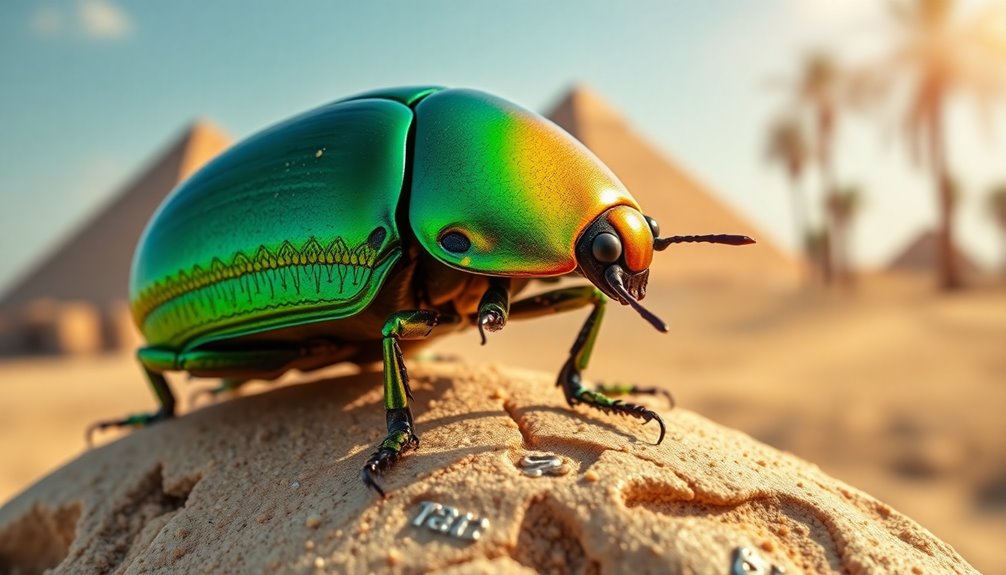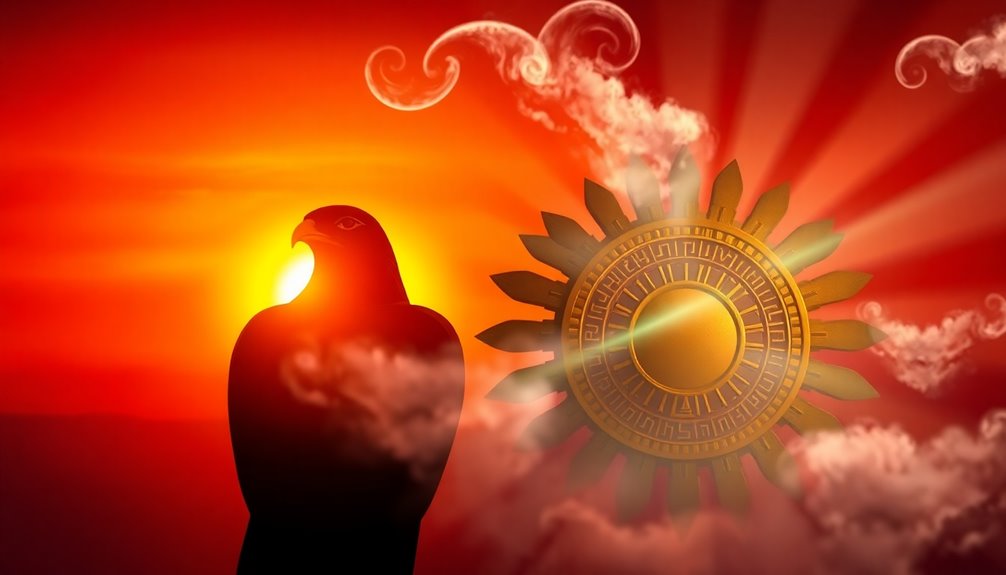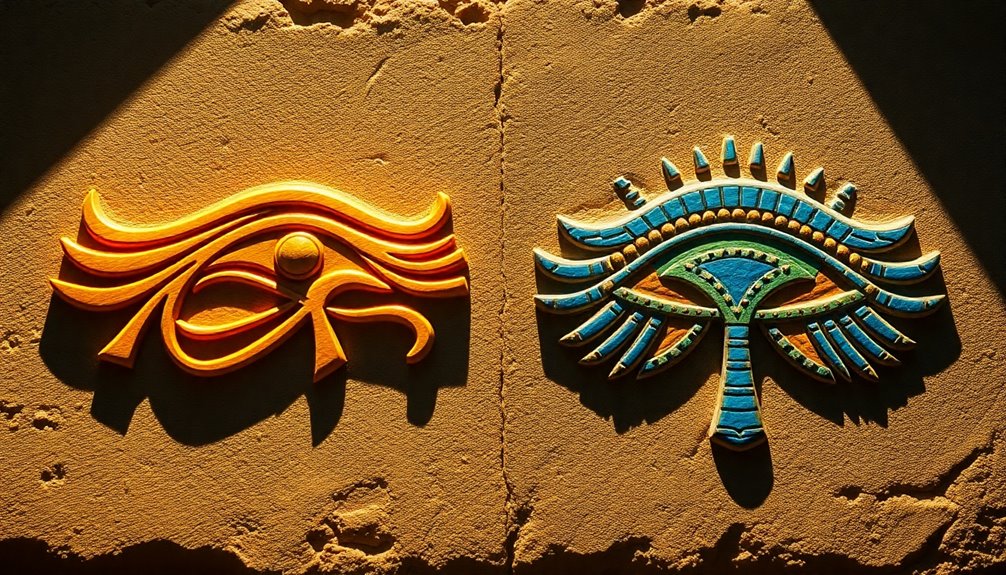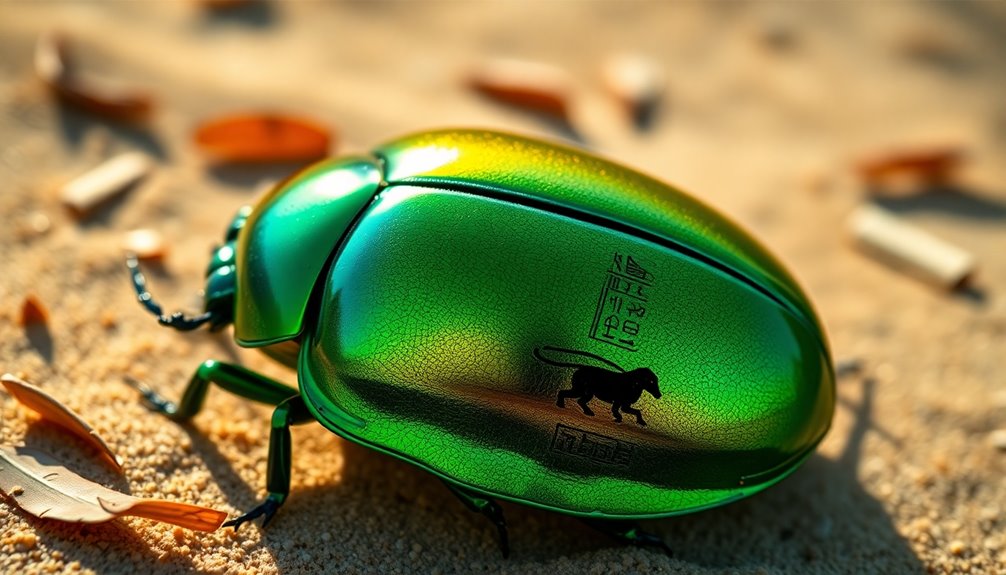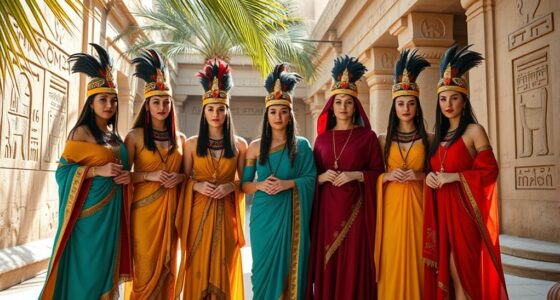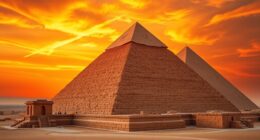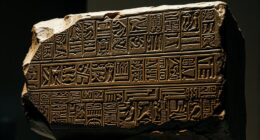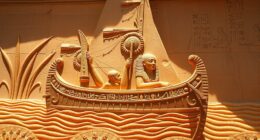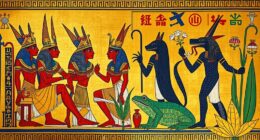Scarab beetles hold a sacred status in ancient Egypt, representing life, death, and rebirth. You might find it fascinating that these creatures, particularly the Scarabaeus sacer, were linked to the sun god Khepri. Their behavior of rolling dung mirrored the sun's daily journey, reinforcing beliefs about renewal. Scarabs were more than just bugs; they served as amulets and protective symbols in funerary practices, guiding souls to the afterlife. As you explore their history, you'll discover how these beetles evolved into powerful symbols of protection, luck, and transformation throughout the ages. There's so much more to uncover!
Key Takeaways
- Scarabs symbolize life, death, and rebirth in ancient Egypt, reflecting the sun's daily cycle and beliefs in renewal.
- Used in funerary practices, scarabs ensured protection for the deceased and guided souls to the afterlife.
- Heart scarabs, placed near the heart during mummification, safeguarded against false testimony during the judgment of the dead.
- Scarabs evolved from simple amulets to intricate decorative objects, influencing neighboring cultures and modern interpretations of protection and good luck.
- Today, scarabs attract tourists and collectors, emphasizing their cultural significance and the necessity for authenticity in the market.
Historical Importance of Scarabs
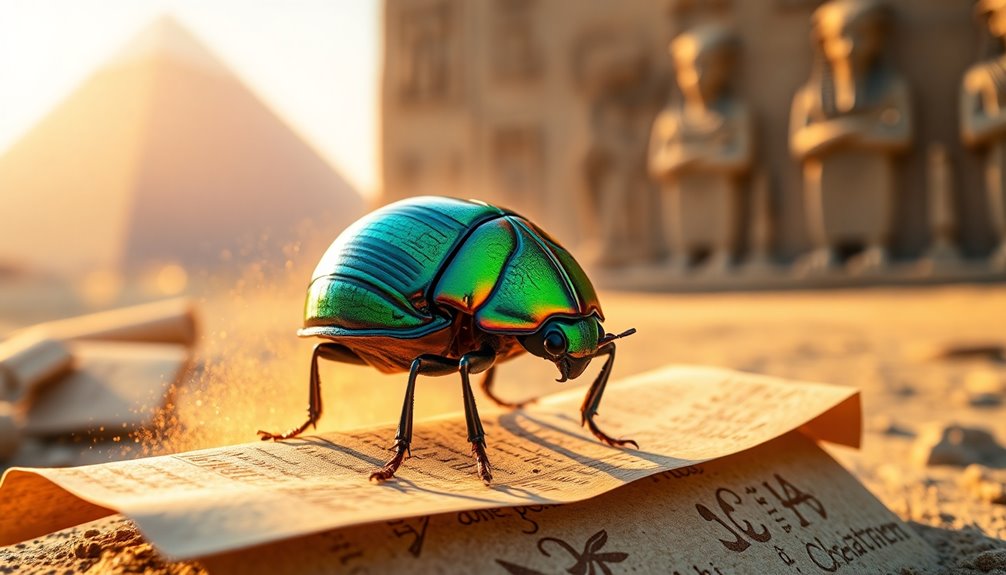
Scarabs held immense historical significance in ancient Egypt, symbolizing life, death, and rebirth. You might be fascinated to learn that these sacred animals, scientifically known as Scarabaeus sacer, were closely associated with the god Khepri. Their behavior of rolling dung balls mirrored the sun's daily cycle, reinforcing beliefs in renewal.
The first scarab amulets appeared during the 6th Dynasty and evolved into intricate artifacts providing protection and good luck. Throughout the Middle Kingdom and into the New Kingdom, scarabs served multiple roles. They were amulets, seals for documents, and jars, often inscribed with names and protective spells.
The Heart Scarab, in particular, played a crucial role in funerary practices, ensuring safe passage in the afterlife as detailed in the Book of the Dead. Scarabs like the one belonging to Hatshepsut showcased not only their protective powers but also the artistry and wealth of ancient Egyptian culture.
These artifacts were produced in large quantities and were accessible to all social classes, highlighting their widespread significance. Fundamentally, scarabs were more than mere symbols; they were integral to the beliefs and practices of ancient Egyptian society.
Artifacts and Symbolism
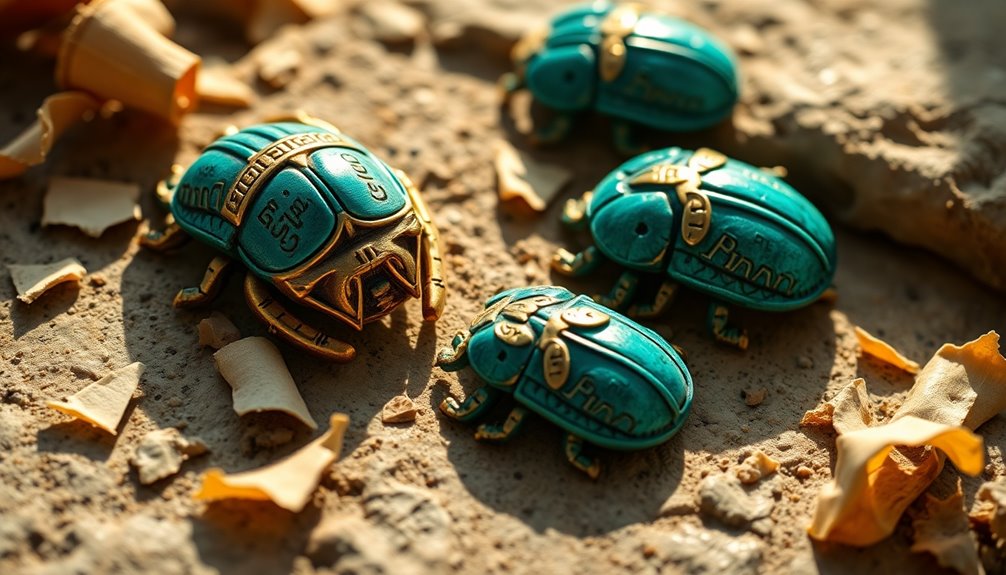
When you explore the artifacts associated with scarabs, you'll find they played a vital role in funerary practices, symbolizing protection and rebirth.
These amulets were often buried with the deceased, reflecting the belief in their power to guide souls safely to the afterlife.
Through their intricate designs and inscriptions, scarabs embody the eternal cycle of life that ancient Egyptians revered.
Scarabs in Funerary Practices
In ancient Egyptian funerary practices, scarab amulets played a significant role in ensuring the deceased's safe passage to the afterlife. These powerful symbols of regeneration were often placed in tombs, reflecting the ancient Egyptian religion's belief in resurrection.
Heart Scarabs, specifically inscribed with protective spells, were positioned on or near the heart during mummification. This positioning safeguarded the deceased against false testimony during the essential judgment of the dead.
Scarabs embodied the eternal cycle of life and death, mirroring the daily journey of the sun, which dies and is reborn each day. This connection to Khepri, the god of creation, reinforced their significance.
The ritual importance of scarabs is evident in funerary texts like Chapter 30B of the Book of the Dead, which emphasizes the heart's critical role in the afterlife journey.
Crafted from durable materials such as faience or stone, these amulets were designed to withstand the test of time. By wearing or placing scarabs, individuals sought not just protection from evil but also fortune in their journey through the afterlife, making them indispensable in ancient Egyptian funerary practices.
Symbolism of Protection and Rebirth
Throughout ancient Egypt, scarabs served as powerful symbols of protection and rebirth, deeply ingrained in the culture's beliefs and practices. These sacred beetles were more than just insects; they embodied the eternal cycle of life.
Often, you'd find scarab amulets placed in tombs, intended to safeguard the deceased in the afterlife. One of the most significant artifacts was the heart scarab, inscribed with spells to guarantee the heart remained silent during judgment, helping the deceased achieve resurrection.
Associated with the god Khepri, scarabs represented self-creation and regeneration. This connection reflected the belief that the sun's daily journey mirrored the life cycle of birth, death, and rebirth.
Artifacts like the Scarab of Hatshepsut, decorated with precious stones, exemplify how the scarab's protective symbolism intertwined with wealth and artistry in ancient Egyptian culture.
During the New Kingdom, scarab motifs appeared in jewelry and decorative objects, showcasing their enduring significance as symbols of good luck and divine protection across all social classes.
These ancient symbols remind us of the deep reverence Egyptians held for life, death, and the promise of rebirth.
Funerary Customs and Beliefs
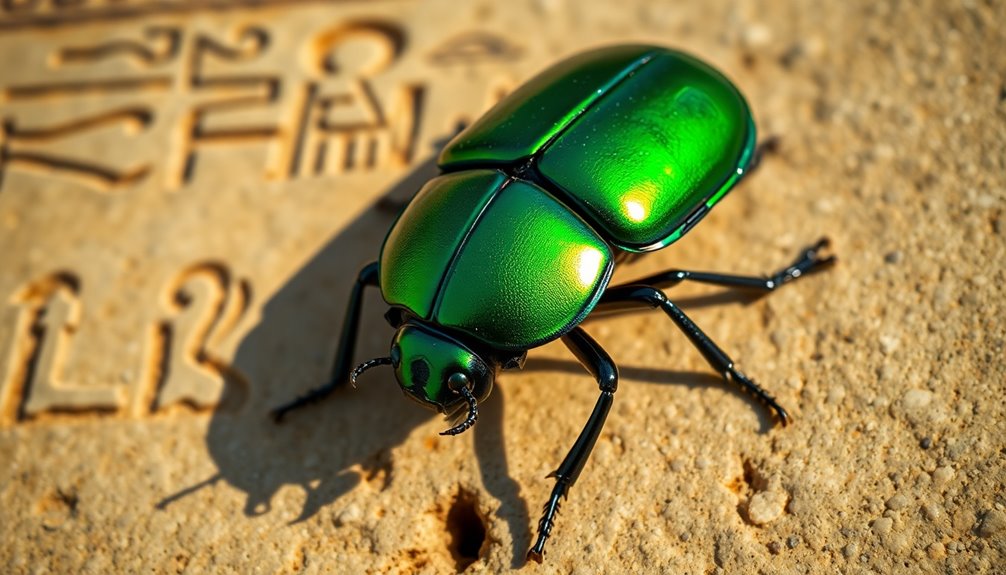
How did ancient Egyptians view the scarab beetle in relation to their funerary customs? They saw the scarab as an essential symbol of protection in their funerary practices. Scarab amulets were often placed in tombs, serving as charms to guarantee a safe journey into the afterlife. This reflects their deep belief in resurrection and eternal life.
Heart scarabs, inscribed with spells from the Book of the Dead, were important during mummification. They were placed on or near the heart to safeguard it during the judgment of the deceased. The scarab beetle's behavior of rolling dung into balls represented the eternal cycle of life and death, linking it to the sun god Khepri's daily resurrection.
Additionally, funerary practices included using scarabs as seals for jars and documents, with inscriptions detailing the deceased's identity and protective spells to ward off evil. The regenerative powers of scarabs were frequently depicted in tomb art, and their presence in burial goods provided comfort and security for the deceased in the afterlife.
Consequently, the scarab beetle was a significant element in the beliefs surrounding death and the journey beyond.
Cultural Influence Through Time
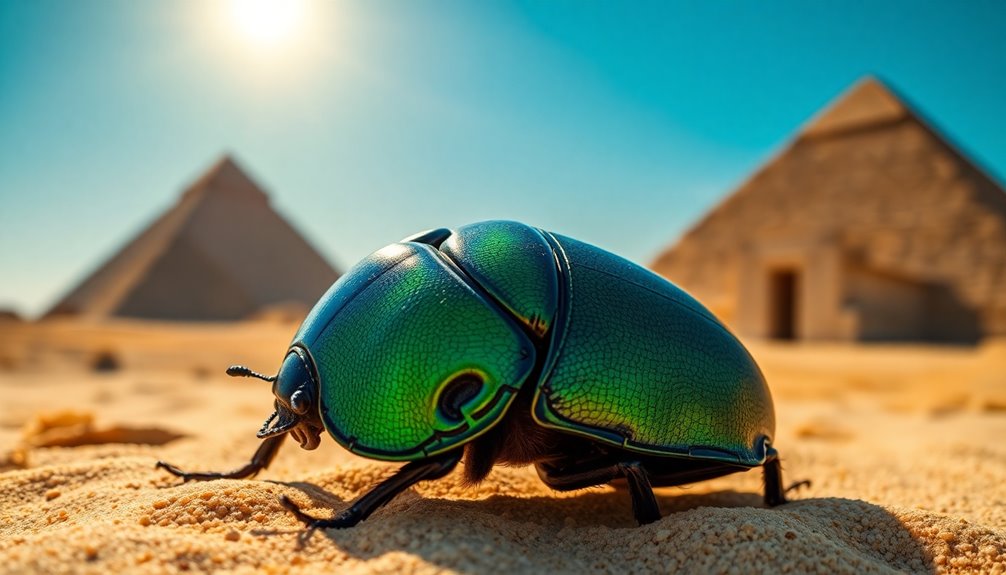
As ancient Egyptians embraced the scarab beetle as a powerful symbol of life and rebirth, its influence transcended time and geography. These sacred scarabs emerged during the Old Kingdom, embodying cultural beliefs that persisted through subsequent dynasties. You'll find that scarabs evolved from simple amulets to intricate decorative objects, reflecting the significance of protection and luck in both life and the afterlife.
| Scarab Type | Description |
|---|---|
| Heart Scarabs | Represented the heart's protection in the afterlife. |
| Commemorative Scarabs | Celebrated royal achievements and significant events. |
Inscribed with names, magical spells, and religious symbols, scarabs served as protective charms and seals for official documents, showcasing their integral role in ancient society. Additionally, the adoption of scarab motifs by neighboring cultures, including the Greco-Roman world, illustrates the far-reaching impact of these insects on artistic expressions and beliefs. Even today, you can see modern interpretations of scarabs that symbolize protection and good luck, bridging the gap between ancient traditions and contemporary culture.
Scarabs in Modern Context
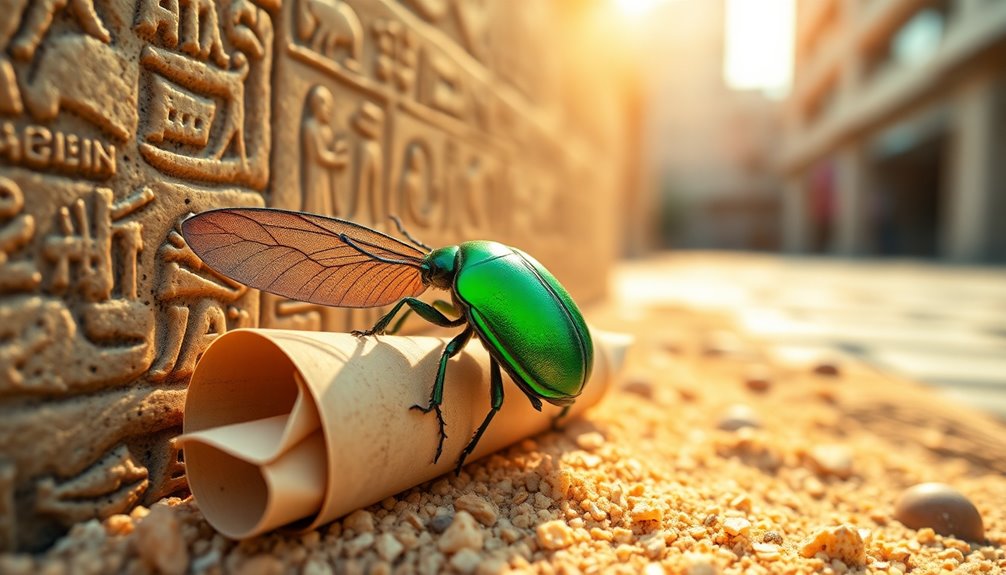
Scarabs are more than just ancient artifacts; they've become trendy symbols in modern fashion and art.
When you see scarab designs in jewelry or tattoos, they often represent rebirth and a link to rich traditions.
Plus, as you explore contemporary Egyptian culture, you'll notice how these beetles play an essential role in tourism and cultural preservation.
Contemporary Symbolism and Meaning
Embodying ancient wisdom, contemporary symbols of scarabs resonate with meanings of protection, good luck, and transformation. The sacred beetle, revered by ancient Egyptians, wasn't just a dung beetle; it represented the cycle of life and rebirth.
Today, you'll find scarabs in various forms, from jewelry to tattoos, embodying the same qualities that captivated past civilizations. Many people still believe in the scarab as a symbol of protection, connecting them to ancient practices that invoke its power.
In contemporary spiritual practices, scarabs are often called upon for their protective qualities, offering a sense of security and guidance. These resilient creatures symbolize regeneration, reflecting life's ability to rise from adversity.
When you wear a scarab or have one tattooed, you're embracing this spirit of rebirth and transformation.
Tourists flock to Egypt, purchasing scarab replicas and amulets, ensuring that the tradition continues. This modern appreciation illustrates how the scarab transcends its cultural origins, evolving into a universal emblem of resilience that resonates with diverse audiences.
Scarabs in Fashion Trends
The enduring allure of scarabs extends into the fashion world, where these ancient symbols have found a fresh expression. Scarabs have become popular motifs in contemporary fashion, often featured in jewelry, clothing designs, and accessories that symbolize protection and good luck. Designers are increasingly embracing innovative materials to create unique interpretations of scarab-inspired pieces, enhancing both aesthetic appeal and sustainability.
You'll find modern jewelry incorporating scarab imagery crafted from gold, silver, and gemstones, reflecting both ancient craftsmanship and today's aesthetics. Fashion designers frequently draw inspiration from the intricate designs of ancient scarabs, leading to unique interpretations in runway collections and casual wear. Collaborations with influencers have also amplified the visibility of scarab designs, making them more desirable among fashion enthusiasts.
You might notice scarab tattoos gaining popularity as well, symbolizing rebirth and transformation. These tattoos are chosen not only for their deep cultural significance but also for their striking aesthetic appeal.
The revival of scarab motifs in fashion aligns with a broader trend of incorporating historical and cultural symbols into modern styles. This trend appeals to consumers like you, who are interested in the heritage and meaning behind your accessories. The scarab also embodies the essence of transformation and regeneration, resonating with individuals on their personal spiritual journeys.
Cultural Preservation and Tourism
Throughout the years, tourism in Egypt has thrived on the rich cultural symbolism of scarabs, attracting visitors keen to connect with ancient traditions. These sacred beetles symbolize protection and good luck, making them popular souvenirs for travelers.
You'll find countless replicas and amulets sold in markets, each crafted to evoke the powerful heritage of ancient Egypt.
When you explore museums and archaeological sites, you can engage with scarab artifacts that highlight their sacred status in ancient Egyptian religion. Educational tours often investigate the historical significance of scarabs, enriching your understanding of their role in rituals and beliefs.
The continued popularity of scarabs in contemporary art and jewelry also reflects their lasting significance. Whether it's a piece of jewelry featuring scarab motifs or decorative items for your home, you can carry a piece of this ancient culture with you.
Tourists and locals alike embrace these symbols as a way to honor the past while celebrating the ongoing legacy of these remarkable creatures. By participating in this cultural preservation, you're not just a visitor; you become part of the vibrant tapestry that keeps these ancient traditions alive.
Divine Associations and Mythology
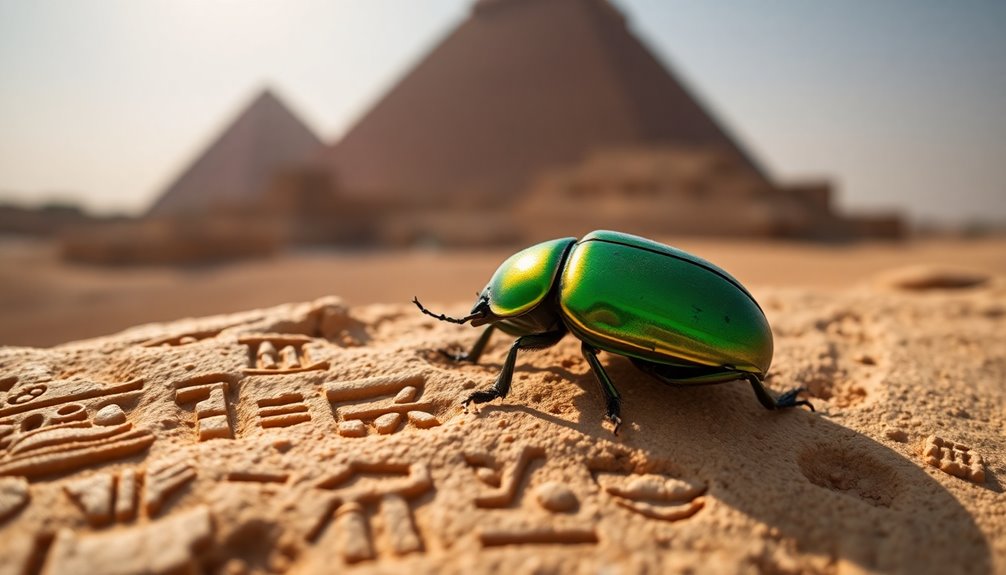
Often revered in ancient Egyptian culture, scarab beetles, particularly Scarabaeus sacer, held profound divine associations that intertwined with mythology and daily life. You might be surprised to learn that these beetles were closely linked to the god Khepri, who symbolized the rising sun and creation. The ancient Egyptians observed how scarabs rolled dung balls, mirroring the sun's journey across the sky. This behavior reflected Khepri's role in the cycle of life and rebirth.
To illustrate the significance of scarabs, here's a quick comparison:
| Aspect | Scarab Beetle | Khepri |
|---|---|---|
| Symbol | Rebirth | Creation |
| Daily Activity | Rolling dung | Rising sun |
| Cultural Role | Protective amulet | God of transformation |
| Associated Rituals | Life and renewal | Sacred ceremonies |
Scarabs were more than just insects; they embodied protective qualities and promised resurrection in the afterlife. The term "Khepri," derived from "hprr," means "to come into being," linking the beetle's life cycle to self-creation and transformation, enhancing their sacred status in ancient Egyptian mythology.
Collecting Ancient Scarabs
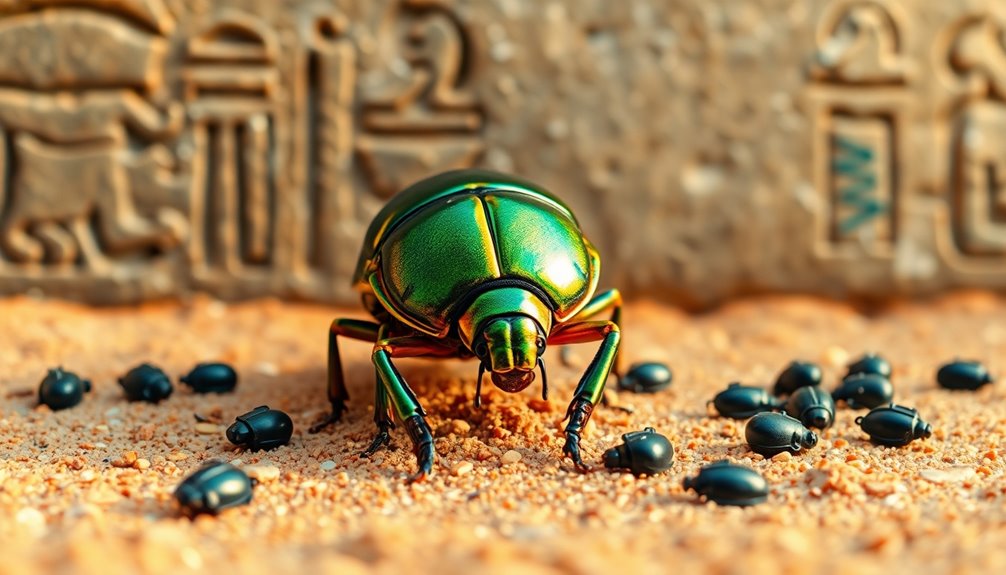
Collecting ancient scarabs offers a fascinating glimpse into the rich tapestry of Egyptian culture and history. These small artifacts, often inscribed with names and protective spells, serve both decorative and amuletic purposes, reflecting their historical significance.
As you immerse yourself in collecting, you'll find that prices vary widely based on size, material, and rarity—some pieces can fetch astronomical sums at prestigious auction houses like Sotheby's and Christie's.
While many scarabs were produced in large quantities, making common types more accessible, rarer examples can command much higher prices. It's crucial to be cautious, though; the high demand for genuine artifacts has led to a market filled with forgeries and illegal trade. Always verify authenticity before purchasing.
The appeal of scarabs extends beyond Egypt, attracting collectors and tourists alike, with modern replicas available for those who admire ancient Egyptian culture.
Frequently Asked Questions
What Does the Scarab Beetle Symbolize in Egypt?
In ancient Egypt, the scarab beetle symbolizes life, death, and rebirth. You'd see it associated with the sun god Khepri, representing creation and renewal.
The beetle's behavior of rolling dung reflects the sun's daily journey, embodying the cycle of life. When placed on mummies, heart scarabs protect the heart in the afterlife.
Additionally, you'd find scarab amulets used for good luck and protection, highlighting their importance in both this life and the next.
Are Scarab Beetles Good or Bad?
Picture a small, resilient beetle rolling a shiny ball of dung under the blazing sun.
In many cultures, perceptions of scarab beetles can swing from good to bad. Yet, if you explore ancient beliefs, you'll find they're often seen as symbols of protection and renewal.
While some might view them negatively, you can appreciate their role in nature, representing life's cycles, and understand why they're often regarded as good omens.
What God Does the Scarab Represent?
The scarab represents the ancient Egyptian god Khepri.
You'll find Khepri associated with the rising sun, creation, and regeneration. When you think of the scarab, picture it as a symbol of life's cyclical nature.
Khepri, often depicted as a scarab or a man with a scarab head, embodies the concept of rebirth and transformation.
This connection highlights the scarab's importance in representing not just life but also the daily renewal of the sun.
Why Were Scarabs Considered Divine in Egypt?
Ever wonder why something so small can hold such immense power?
In ancient Egypt, scarabs were considered divine because they symbolized the cycle of life, death, and rebirth. Their behavior of rolling dung balls mirrored the daily journey of the sun, linking them to creation and regeneration.
You'd find them in funerary practices, believed to protect souls and guarantee safe passage to the afterlife, making them essential for everyone, from commoners to royalty.
Conclusion
In exploring the sacred status of scarab beetles in ancient Egypt, you've uncovered a fascinating blend of history, mythology, and cultural significance. These tiny creatures, once revered as symbols of rebirth, still captivate modern collectors and enthusiasts, much like how a vintage vinyl record draws music lovers today. By understanding their role in funerary customs and divine associations, you gain a richer appreciation for how scarabs shaped Egyptian life and continue to influence us.

